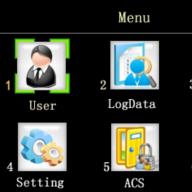Creating a new folder
To create a personal folder, go to Yandex.Mail, then go to the “Settings” menu (the gear icon in the upper right corner of the page) and click on the “Folders and Labels” link.In the “Folders” block, click on the “New Folder” button and proceed to setting it up.
Setting up a new folder
In the window that appears, specify the name of the new folder. If you want to attach a folder to an existing one, click on “Attach to another folder” under the name field. By default, new folders are nested in the standard Inbox.If you want only certain letters to be put into a new folder, click on the link “Yandex.Mail can automatically move certain letters to a folder” - fields will open to set up a rule according to which some letters will only go to your new folder. To do this, indicate the address (or part of it) from which such letters should come, as well as their subject. Should only emails with attached files go into the folder? Then check the “Email contains attachments” checkbox.
If three parameters for filtering letters into a new folder are not enough for you, move on to a more flexible setup of mail processing rules - to do this, click on the link “I need more complex conditions” and describe all the necessary rules for sorting letters for the new folder.
After describing the rules for parsing mail, click “Create Folder” - the new folder will instantly appear in the list of Yandex.Mail folders.
Return to the “Letters” section and to see all your personal folders, click on the checkmark to the left of the “Inbox” link - a list with your new personal folders will expand.
Working with and managing new folders
You can put any letter into a new personal folder directly from the letter itself or from the list of letters. To do this, open the letter or tick several letters in the list, then click on the “Move to folder” link under the search bar at the top right and select the desired folder. In the menu that appears, you also have the opportunity to quickly create another personal folder by clicking on the “New Folder” link.You can clear, rename, set up a rule or delete a personal (but not standard) folder at any time, and also mark all letters in the folder as read - to do this, go back to the “Settings” menu, then “Folders and Marks”. In the same section, personal folders can be moved among themselves, including nesting into each other by simply dragging with the mouse.
Read about how to sort letters in Yandex email
Method I: create new folders, then move the corresponding Mail ru letters into them
To create a new folder for Mail ru letters, click on the “Folders” link:
We get to the “List of Folders”, where we see the mailbox volume scale:

The figure 1 MB means that that much space is taken up by existing Mail.ru emails. Initially, the total size of the mailbox is 10,240 megabytes; when full, you can increase it by another 2 gigabytes.
Click on the “Create a new folder” button and in the window that appears, enter the name of the new Mail folder, for example, “ ”: 
The parent folder is the one in which the new folder will be located. If you select “No (folder at the top level)”, then the new folder will not be nested anywhere and will remain at the same level as the “Inbox”, “Spam”, “Sent Items” folders. I want to sort the Mail ru “Inbox” letters, so I select “Inbox” as the parent folder.
We entered the name of the new folder, we figured out the parent folder, so click on the “Create” button. As a result, we see a new folder “Computer Literacy”, nested in the “Inbox”:

Finally, click on “Inbox”. We find a letter to move to a new folder. We grab it with the left mouse button and, without releasing the left button, drag it to a new folder, after which we release the mouse button.
Thus, one letter was placed in the desired folder. You can also use the mouse to move other letters to the appropriate folders.
Method II: select the mail ru letter and place it in a new or existing folder
Select one or several mail ru letters at once by checking the box next to the letter:

Then click on the “Move” button:

In the drop-down menu, select the folder where we want to move this letter and click on it. The selected letter appears in the desired folder.
For a letter marked with a checkmark, you can immediately create a new folder. To do this, click on the “Move” button, in the window that appears, use the scroll bar to move down and click on “- new -”.

After this, create a new folder as described above in the first method.
As a result, a new folder will be created and the mail ru letter, marked with a checkmark, will be immediately moved to it.
Video “Sorting Mail ru letters into folders”
More information about working with Mail.ru mail can be obtained by contacting. For example, help “Actions with folders” is located here: http://help.mail.ru/mail-help/mailbox/folders/action
This section is intended for creating new folders in mail for distributing letters. Folders help you organize your mail by distributing letters by topic or other parameters. Folders also allow you to block access to certain emails by locking the folder with a password.
Go to settings - button in the upper right corner, next to the “Exit” button or click the “More” button and select “Settings”.
Select the “Folders” section either in the list on the left or on the right with an icon in the form of a yellow folder with a lock drawn on it.

The page contains a list of existing folders. At the top of the list is the “Add Folder” button; by clicking this button, you can accordingly create a new folder for letters. For example, let’s create a “Personal” folder and click “Add Folder”.

In the first field, write down the name of the new folder (any name is possible, but I’ll create “Personal”). In the second line, select the nesting level, that is, it’s like in the operating system, either this folder will be visible and it will be equal to others, or it will be located inside another folder. To make it more clear, I’ll create a folder nested in the existing “Inbox” folder. I open the “First level folder” field and select the “Inbox” folder.

Now select the folder availability. “Not available for email programs (POP3)” - this means that if you check this box, you will not be able to open this folder from email programs, such as Bat, Microsoft Outlook, and the like. In this case, letters from the folder can only be opened in Mail.
You can create a password if someone else has access to your mail. To create a password, check the “Folder is password protected” box.

Additional lines appear to be filled in - we enter the password for the folder twice (you can see how to create a password in the “registration in mail” section), after the password we enter a secret question, the question is not selected, but is invented independently. The following is the answer to this question. The answer and the question do not have to be logically interconnected, the main thing is that you can later remember this answer. The answer is intended for password recovery; I do not advise you to write just anything, as one day you will definitely forget your password.
In the bottom line, enter the password for the Mail mailbox, that is, for the mailbox in which you are currently located. If you don’t remember your password, go to the “password recovery” section. After filling in all the data, click the “Add” button.

Now a new folder called “Personal” has appeared in the list of folders. If you point at a new folder, two buttons appear on the right - settings, and - delete folder. In the folder settings, you can rename the folder, make it inaccessible to email programs, and close it with a password. In general, this is all that we specify when creating a new folder.

If you hover your mouse over the main folders that already existed when you entered, then two buttons also appear - “Clear” and - settings. You can only delete folders that you created yourself. When clearing a folder, all letters stored in this folder are deleted.

Now we go to the main menu to look at the result of our actions; to go, click “go to inbox” in the list on the left.

A new one appeared among the folders - the one that was created. The Personal folder is located below the Inbox folder and can be hidden or shown using a triangle in the Inbox folder.
In a previous article, I talked about how you can sort emails by folders (labels) in the GMail mail service. And in this article I will show you how to organize incoming letters into the required folders in Yandex mail, in which this process is even more intuitive than in Google.
Now I will not delve directly into the essence of this whole division of letters into folders, since I already wrote about this in more detail in a previous article (see the link above).
If in GMail mail folders are correctly called “shortcuts” and you won’t see the word “folder” there, then in Yandex it is the concept “folder” that is used for letters.
Creating folders for sorting letters in Yandex
In Yandex, folders are created simply.
On the left in your personal mail account there are main folders, such as “Inbox”, “Sent Items”, “Deleted Items” and under them there is a link “Create a folder”. Click on it:
In the window that opens, you need to indicate the name of the folder and such that you will later understand what kind of letters it contains :) It is clear that by naming the folder “123”, you are unlikely to understand what kind of letters are in it :))
Here you can select the “parent” folder, i.e. the one in which the created folder (subfolder) will be placed.
For example, there is a folder called “Company A”, in which you will receive all letters from company “A”. And since letters can be from different people and for different purposes, you can create several more subfolders in that folder, for example, “From management”, “Reports”, if, of course, you need such detailed sorting.
To create such a subfolder, click “Attach to another folder” and select the desired parent folder.
All. You can click “Create folder” at the bottom and it will be created.
The principle of sorting letters into folders in Yandex
You can sort letters into created folders in Yandex in 2 ways:
Manually. That is, having selected the desired letter, move it to the desired folder;
Automatically. By creating special rules (conditions) for transferring certain letters to the required folders immediately when they arrive in the mail.
Manually moving emails to a folder
Manually transferring a letter or several to the desired folder is done like this...
Select one or more letters from the list that you want to move to another folder, click “To folder” and from the window that appears, select which folder they will be moved to.
Or you can open the letter itself and do the same. No difference.
Automatic placement of letters into the required folders
Automatic placement of letters can be configured directly when creating the folder itself.
To do this, in the folder creation window, click “Yandex.Mail can automatically move …”.
In the window that opens, conditions will be given (“Put in a folder if”), with which you can set up automatic forwarding of letters.
For example, you can fill in the address in the “From” condition or part of the address, and as a result, if when the letter arrives in the mail, the sender’s address matches what you specified in that condition, then it will work and the letter will be sent to this folder.
To make the condition more “narrow”, you can also specify a topic. As a result, two conditions will be checked at once: address and subject of the letter. And only if both of them correspond to what you specified, the letter will be sent to the desired folder.
Here, if necessary, you can proceed to setting up more complex and flexible conditions by clicking “I need more complex conditions.”
In the window that opens, you can create more complex conditions and actions for incoming letters.
The principle is similar: you specify the condition itself and choose what to do with the letter if this condition is met.
You can also get to creating conditions and actions with letters through the “Mail Processing Rules” subsection of the general settings.
Action on folders (delete, rename, configure)
Created folders can be easily deleted and renamed. You just need to right-click on the folder in the list and select the appropriate action from the pop-up window:
If you need to configure folders in more detail, click “Folder and Label Settings” in the same menu. This will take you to a separate window where you can change the arrangement of folders on top of each other, nest one folder in another, and create conditions for moving letters into them.
Conclusion
When letters are sorted into folders, it is easier to work with mail and, most importantly, more convenient, because everything is sorted into shelves. In Yandex, as you already understood, creating folders, managing them and sorting emails by them is very simple and intuitive. Therefore, I recommend that owners of Yandex mail take this into account if they are not already using it!
All correspondence is distributed into folders. The mailbox contains 5 system folders that are created automatically and cannot be deleted or renamed. In addition to system folders, you can create your own personal folders.
Folder navigation is available on the left side of pages with lists of letters. The system folders are listed at the top: Inbox, Sent Items, Drafts, Spam, Trash; your personal folders will be displayed below. Next to the folder name, the number of new (unread) messages in it is displayed. if they are.
SYSTEM FOLDERS
"Inbox"- the main folder, by default all incoming (new) letters that arrive in your mailbox go into it.
"Sent"- this folder contains letters sent from your mailbox. In order for your letters to be saved in this folder, when creating a letter, be sure to check the box "Save to Sent". By default, the checkbox is set automatically; this can be changed if necessary. To do this, go to the section "Settings" "Are common" and uncheck "Save to Sent", save changes. Then, when writing a letter, the “Save in sent” checkbox will always be unchecked automatically. In the same way, you can return the default setting for saving sent emails.
In folder "Drafts" Your unfinished and postponed letters that you intend to send later are stored. To save the letter in this folder, click the button "Save" when writing a letter.
In folder "Spam" emails that you have marked as SPAM are stored.
"Basket"- This folder stores letters that you have deleted from other folders. Saving deleted emails in the Trash folder works by default, but you can change this if necessary. To do this, go to the section "Settings"(menu bar at the top of the page), then go to the settings page "Are common" and uncheck/check the box DeleteAdd to cart. Don't forget to press the button "Save".
PERSONAL FOLDERS
You can configure personal folders at your discretion: add a new one, rename the current one, clear or delete a folder. To go to managing personal folders, click on the link "Folder Management" under folder navigation (see Fig. 1).
The folder management page will load (see Fig. 2). The page displays a list of all folders, including system folders, but for system folders only the action is available " Clear folder". For all folders in the list, the number of unread emails and all emails in the folder are indicated.

Rice. 2. Folder management.
To create a new folder, enter its name in the "Folder Name" text field and click the button "Create a folder"(see Fig. 3).
Rice. 3. Create a folder.
You can rename a personal folder, to do this, click on the icon "Change" in the list line. In the window that appears, edit the folder name and click the button "Save"(see Fig. 4).
Be careful! If you have filters that use this folder, then renaming the folder will remove the filters.

Rice. 4. Rename the folder.
You can delete all letters from both your personal and system folders. To do this, click on the icon "Empty folder" in the list line.
Please note that deleted emails cannot be returned in this case. The system will display a dialog box to confirm the removal of all letters from the folder (see Fig. 5). If you are sure that the letters need to be deleted, click the " Clear".

Rice. 5. Confirmation of deletion of all letters in the folder.
You can delete not only all letters from a folder, but also the entire folder, to do this, click on the icon "Delete folder" "Delete". In this case, the folder itself and all its contents will be deleted.
In this case, deleted folders and letters cannot be returned. In addition, all filters using this folder will be deleted. The system will display a dialog box to confirm the deletion of the folder (see Fig. 6). If you are sure that the folder needs to be deleted, click the " Delete".

Rice. 6. Confirmation of folder deletion.




